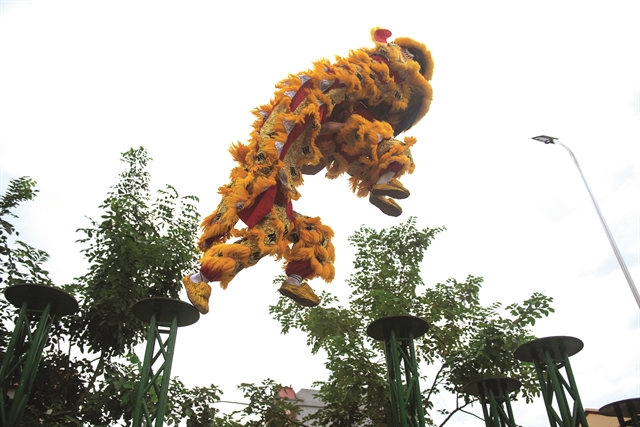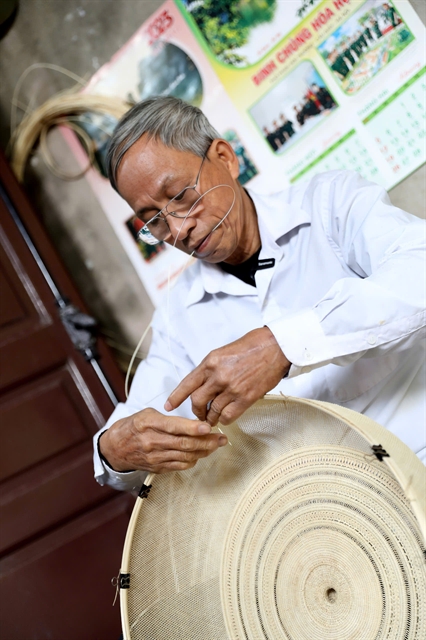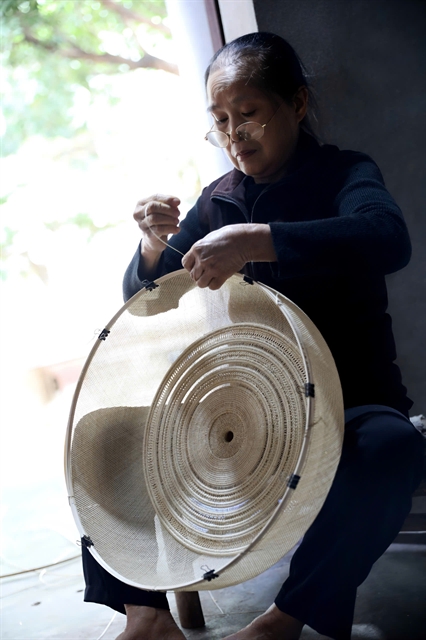 Sunday/Weekend
Sunday/Weekend

 |
| Artisan Nguyễn Thị Tiến is weaving a dish-cover. — VNS Photo Đoàn Tùng |
By Thanh Nga
Nestled 25km from the bustling heart of Hà Nội, Phú Vinh Village in Phú Nghĩa Commune, Chương Mỹ District, has been a hub of bamboo and rattan wickerwork for over 400 years.
Among its most renowned products today are the delicate rattan wicker dish-covers (rattan netting used for protecting food from flies) crafted by 75-year-old Trần Văn Khá and his wife, Nguyễn Thị Tiến, 72.
These dish-covers, woven from thousands of rattan wickers as fine as silk threads, weigh just 290 grams but are valued at up to VNĐ30 million (US$1,200) each. While originally designed to cover food trays, they are now cherished as valuable decorative pieces in homes.
 |
| A dish-cover, woven from thousands of rattan wickers as thin as silk threads, weighs only 290 grams. — VNS Photo Đoàn Tùng |
Entering their modest home, one is immediately surrounded by an array of bamboo and rattan pieces, the essential materials for their creations. Khá meticulously prepares each rattan strand, while his wife Tiến, who learned the craft since the age of six, skillfully weaves intricate patterns into the elegant dish-covers.
“The rattan wicker dish-cover is our own creation,” Khá told Việt Nam News. “It takes about 16 to 20 days to complete a piece, as it involves many painstaking stages.”
 |
| According to artisan Trần Văn Khá, It takes about 16-20 days to complete a rattan wicker dish-cover, as it goes through many intricate working stages. — VNS Photo Đoàn Tùng |
Born into a family with a long tradition of bamboo and rattan weaving, Tiến has been perfecting her craft for decades. Her products are recognised as the finest in the region and are often ordered as prototypes.
Khá fondly recalled, "When my wife was young, she was the fastest weaver in the village, with a speed two to three times that of the average person."
In 2003, Tiến proposed using rattan wicker to beautify the traditional dish-cover -- a utensil on the dining table in every northern Vietnamese household. At that time, no one in the village was producing it, so Khá quickly supported his wife’s idea.
“Back then, we worked day and night, and after more than a month, we completed our first product,” Khá recalled. “When we introduced it to the market, it was warmly received. Customers had to wait about five months to get one, and its price was around VNĐ6 million.”
Over the years, the elderly couple has refined their craft, increasing the number of rattan strands from 300 to 1,200. The process now takes about three days to create the knob, seven days for the tray, and another seven days for the frame.
Artisan Nguyễn Văn Tĩnh of Phú Vinh craft village praised the couple's work, saying, "These dish-covers are the culmination of the finest traditions of Phú Vinh’s rattan and bamboo weaving, passed down through generations. The entire product weighs less than 300 grams, a testament to their meticulous craftsmanship. In the village, only Khá’s family creates these thinnest, lightest, and most exquisite rattan wicker dish-covers."
 |
| Thanks to their passion and dedication, the elderly couple's unique handmade rattan wicker dish-covers have attracted customers both at home and abroad. — VNS Photo Đoàn Tùng |
Thanks to their passion and dedication, the couple’s unique handmade dish-covers have attracted customers both locally and internationally. Their creations were exhibited by the Việt Nam Handicraft Exporters Association (VIETCRAFT) in early 2010, and from 2012 to 2014, the couple was invited to showcase their skills abroad.
Their craftsmanship has been recognised at the highest levels, with their creations winning first prize at the Việt Nam Handicraft Product Competition in 2020. These accolades are a testament to their unwavering commitment to their craft.
However, despite their success, the couple faces a bittersweet challenge. None of their children have followed in their footsteps, and they worry that this unique craft may be lost as they grow older.
“My family has many children and grandchildren, but none have taken up the craft,” Khá said.
“Many people in the village have come to learn, and we’ve taught them wholeheartedly, but no one has yet mastered this type of dish-covers. Now that my wife and I are old, I fear that this craft will be forgotten, so I’ve made one for each child in my family to keep as a lasting memento.” VNS
 |
| Tiến hopes to inspire the next generation to carry on this sophisticated craft. — VNS Photo Đoàn Tùng |




